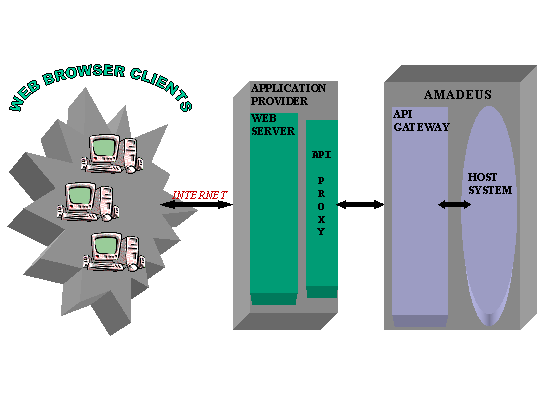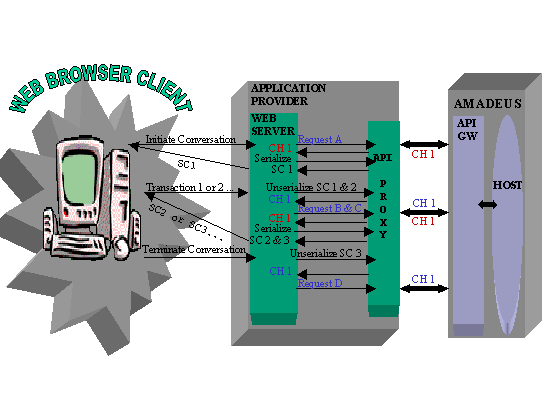|
Connecting to the Amadeus API Gateway with a Server Application
|
With an Amadeus Server Application, you will be providing multiple users access to the
Amadeus API gateway via a server(architecture is not limited to a single server). Your
server will be responsible for managing the transactions between your users and the
Amadeus API gateway via the API functions provided.
A conversation handle will
be returned to your server when a conversation is initiated via the
openConversation function provided.
This conversation handle will be the link between your user and the
Amadeus host system resource. Your server will be responsible for maintaining this link,
as it must be referenced within the user transactions.
To facilitate simple management of the conversation handle on your server, the Amadeus
API provides functions that will serialize and
unserialize conversation handle.
The functions transform a conversation handle into a simple printable ASCII
string (so called "serialized context" or "serialized
conversation") and vice versa. The serialized context can be easily exchanged
across the network between distant machines, eliminating the need for complex manipulation and
maintenance of the conversation handle for your server.
When your user has completed the desired transactions, the conversation link must be
terminated with the Amadeus host system via the closeConversation function provided.
|
Understanding the serialization concept
|
Before moving on to view a logical scenario for managing your conversations in a server architecture,
it may be beneficial to better understand why the serialization functions provided will be of
particular interest in your developments.
Although it is not mandatory that you utilize the serialization functions provided, we believe
that the implementation of these functions within your application will simplify your development.
Study the following development scenario of a Virtual Travel Agency to further illustrate this
point;
In this instance, the Virtual Travel Agency is a web site that enables distant customers
to make their travel reservation over the internet. The customers connect to the web site
with their web-browser. The Agency provides their customers with information such
as flight availability, flight fares, etc... Using the following Amadeus API architecture
provides an easy way for the web-server to connect to the Amadeus Global Distribution
System for the information required.

Consider the following conversation that might take place:
A web browser user will connect to the web server and want to initiate
a conversation.
The web server instantiates the conversation with the API Gateway via
the API Proxy, creates a user web page, and returns the corresponding web page to the user.
The user then sends a request for some flight availability information
to the web server.
The web server uses the API Proxy to request the information from the
Amadeus host system, translates the information given back into a web page, and returns the
corresponding web page to the user.
The user then decides to sell a flight from the information and
sends his request to the web server.
The web server uses the API Proxy to make the sell within the Amadeus
host system, translates the response given back to a web page, and returns the corresponding
web page to the user.
Finally the user is finished and sends a request to the web server to
terminate the conversation.
The web server uses the API Proxy to terminate the conversation, creates a
final web page, and returns the corresponding web page to the user.
Although the conversation in our Virtual Travel Agency seems quite simple, it becomes a bit more
complex when remembering that the link between the web browser user and the Amadeus host
system is the conversation handle that is returned to the web server. Meaning,
that the web server is responsible for maintaining the association between the user and
the appropriate conversation handle until the conversation is terminated by the user.
Having a stateful web server can certainly handle the responsibilities but may involve increased
costs of creating a remanence mechanism or adding on off-the-shelf plug-ins to make the server
stateful. Not to mention, that the stateful web server will not be reliable in the case of a
server crash nor will it provide the ability to load balance because of its' lack of
scalability.
In addition, imagine if this Virtual Travel Agency were dealing with a distributed environment
containing a farm of web servers. The implementation of the API in such an environment
would be very difficult and could be very costly.
Serialization becomes the clear choice to minimize development efforts and make the Virtual
Travel Agency most reliable and efficient in any environment. Here's how:
The web server uses the API Proxy to locally serialize and unserialize the conversation
handle for each transaction it receives from the user.
The conversation handle becomes a printable string of ASCII text that is easily and
transparently transported across multiple networks by being incorporated into
the web pages that are sent between the web server and the browser user.
Each new request that is sent to the web server automatically contains the serialized
conversation handle from the previous transaction which allows any web server to locally
unserialize it and obtain the real conversation handle to be passed through to
the Amadeus host system by the API Proxy.
A logical scenario from an Server Application to open a conversation, request multiple
information, and close a conversation follows:
Conversation_handle = openConversation(connection_parameters)
Serialized_handle = serializeConversation(Conversation_handle)
Send response to the user
Conversation_handle = unserializeConversation(Serialized_handle)
doTransaction1(Conversation_handle, query, response)
doTransaction2(Conversation_handle, query, response)
...
doTransactionN(Conversation_handle, query, response)
Serialized_handle = serializeConversation(Conversation_handle)
Send response to the user
...
Conversation_handle
= unserializeConversation(Serialized_handle)
closeConversation(Conversation_handle)
Send response to the user
|
It is possible to perform transactions in parallel using several conversations.
|
Multi-threaded application considerations
|
In a typical server application, many users will be connected to the server application
at the same time. These users will be sending queries, and receiving replies, simultaneously.
The typical application will therefore need to be multi-threaded, and manage many conversations
in parallel. It is perfectly valid for multiple simultaneous threads to work with multiple API
conversations in parallel. There is one impotant consideration to note however.
Multi-threaded Client applications should take care that multiple simultaneous threads, do
not use the same Conversation handle, at the same time.
If this occurs, the following behavoir may be observed, and should be avoided:
- The API proxy locks the conversation and protects itself from multiple sends.
E.g. Thread 1 with ConversationHdle1 calls CAI_SendAndReceiveXML, and waits for a reply.
Meanwhile Thread 2 also with ConversationHdle1 calls CAI_SendAndReceiveXML. The call in
Thread2 will be rejected with 'ENTRY IN PROGRESS' as the API Proxy has locked ConversationHdle1.
ConversationHdle1 has been locked by Thread1.
- The API proxy cannot lock and protect conversations during a 'hard' close.
E.g. Thread 1 with ConversationHdle1 calls CAI_SendAndReceiveXML, and waits for a reply.
Meanwhile Thread 2 also with ConversationHdle1 calls CAI_CloseConversation or
CAI_CloseConversationFromFactory - The call in Thread2 will not be rejected. It is a
'hard' close. Thread1's behaviour will now become unpredictable!
|
Conversation Management with API Functions
|
- CAI_openConversationByCorporateId
- CAI_openConversationByAtid
- CAI_openPassiveConversation
- CAI_openConversationFromFactory
- CAI_initFlatConversation
- CAI_initAuthentication
- CAI_initConnection
- CAI_initOpenType
- CAI_initCustomSign
- CAI_releaseFlatConversation
- CAI_releaseConversationFactory
- CAI_releaseXXXInput
- CAI_releaseXXXInput
- CAI_serializeConversation
- CAI_unserializeConversation
- CAI_serializeConversationFromFactory
- CAI_unserializedConversationFromFactory
- CAI_closeConversation
- CAI_closeConversationFromFactory
- CAI_getVersion
- CAI_getErrorStr
- CAI_sendAndReceiveXML
| Term |
Definition |
| AMADEUS system resource |
File in the AMADEUS system that contains the context of the transactions.
It corresponds to your instance in the AMADEUS system.
|
| API Server |
Server which carries the requests and the responses between your application
and the AMADEUS system.
|
| Atid |
Reference on a dedicated resource in the AMADEUS system.
|
| conversation handle |
Handle on the conversation.
It represents a channel opened between your application and the AMADEUS system.
|
| Corporate id |
AMADEUS identification of your corporation.
|
| Interface |
Set of functions that cover an AMADEUS functionality.
|
| Password |
Word which permit the authentication of either a user or an atid belonging to a corporate id.
|
| User id |
AMADEUS identification of a user in the corporation.
|

